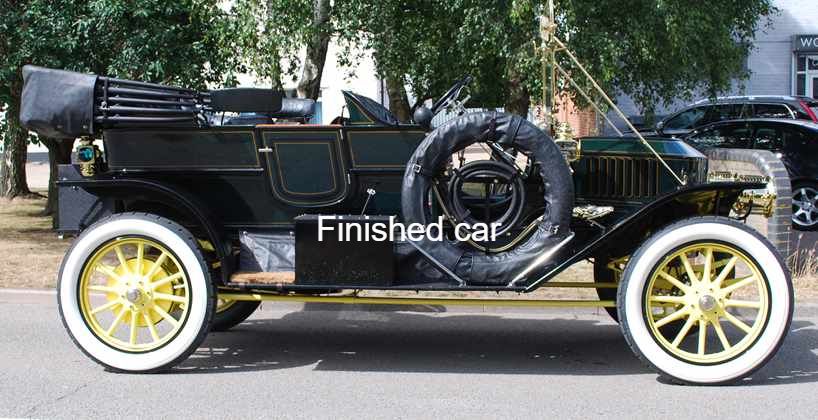The restoration of a Stanley Model 8511/8/2018 PART ONE The restoration started as a tidying up of the car. It ended up a full nut and bolt restoration. After a very detailed inspection of the car it was obvious that major work was need to all parts of the car. The owner agreed to have the work done by my company on an hours and parts costing.It was impossible to quote a price from the outset. Basil Craske UK The entire car was then taken apart . After completely taking the car apart we commenced the major restoration work.
First job was to dismantle the engine. During the dismantling it was discovered that the main gear as well as the eccentrics were loose on the crank pin and moving slightly back and forth, the reason for this was the key-ways were wider than the key, this fault leading to crank pin wear. A new crank pin was made and a new key way cut . At the same time balance weights were made and added to the crank in an attempt to stop the engine vibration which occurred at around 40 MPH. We were informed by many steam car friends in America that this was the method used to overcome the problem. The pistons were also found to be loose on the piston rods, the piston rods were also loose on the cross heads. These problems were fixed by tightening the nut holding the pistons in place and then locking the nut in place. New rings were also made and fitted. The piston rods were only held in place in the cross-heads with a split pin. We fitted a lock nut and reassembled the rods to the cross-heads and then locked them in place again using the lock nut with thread lock and a split pin. The bores were honed and the valve faces in the block re-faced. New valves were needed as they were found to be too badly worn to re-use. New valves were cast and machined and then lapped in. The engine was then assembled. When we timed the valves it was discovered that we could not get a full valve opening. The reason was found to be the brass fork which operated the D link movement needed the stop re-machining to allow more travel on the D links. Once done we were able to set the valve timing. This was done in full hook up. Once satisfied we fitted the end and steam chest covers. The engine was run on air and it turned over at 90 PSI without trouble. The chassis was next on the restoration list. The back axle was taken apart as cracks were spotted in the axle case tubes. The entire axle and cases were taken to a local non destructive testing company. Many cracks were found, this resulted in new axle cases being made using the original castings, once they had been re-removed from the axle tubes and tided cosmetically. Excessive clearance on the planet gears with around 20 thou clearance was discovered. Add this to the 25 thou clearance on the main engine gear to diff gear answered the question regarding the noise from the back end when driving the car. Combined to this the engine problems and excessive clearance on the cross-heads to piston rods etc I am sure you can guess how noisy the back end was. New brake back plates were made and installed, as well as new wheel cylinders . A new brake drum pattern was made and castings ordered.The new brake drums were machined and fitted; the old brake drums were badly worn, cracked and far too heavy. New brake adjusters were also made as it was found that the ones on the car must have failed in the past and were welded up solid?? So no adjustment was possible. All the painted parts of the rear axle were sand blasted and primed ready for a top coat of paint. The axle was then reassembled with 3 thou clearance set on the planet gears. New hand brake linings were fitted to the band brakes. The front axle was next to restore. A damper had been fitted to the steering to help stop the steering shake. New king pins and bushes were manufactured and fitted. The damper was removed. At the same time mounting brackets were fitted to allow the mounting of the newly purchased calipers . A disc brake pattern was also made and from this discs were cast, these were then machined and fitted. New wheel bearings were also installed. The tie rod ends were very loose so were reset to the correct clearance, the same job was done to the steering drop arm . Later tests showed that the steering damper was no longer needed as the steering had no shudder and was now quite light to steer. More information regarding steering improvements will be discussed in later articles regarding the restoration. The front axle was assembled and checked and passed, it was dismantled, shot blasted and primer paint applied ready for top coat paint. It was then reassembled. The perch poles and chassis tie rods were checked. They were then shot blasted and primed ready for top coat paint. The entire chassis was then assembled ready for paint. New nuts were made for the perch pole rods' threaded ends. These were then nickle plated. The customer, following our advice, had already purchased and fitted new Calimer wood wheels with Stanyweld rims from Coker tyres. Five new white wall tyres had also been purchased. The wheels were prepped for paint. The old wheels were made of cast aluminium , the spokes being very thick and not just out of proportion to wood style wheels , but also weighed 4 times as much as a wooden wheel. With this the engine and rolling chassis were now finished. We now turned our attention to the body. First thing was the the removal of the hood (top) and the seats from the main body.The leather upholstery was then removed along with the 2 swivel seats that are fitted to the long wheel base body on this one of the few true 7 seat Model 85 Stanley`s made. The boiler ring and steel sections around the burner bay were removed, this was made of 3/8 thick steel 3 inches wide.The sizes were well over spec leading again to excessive weight being added to the car.This steel work was remade to the style of the model 70 Stanley, but a different boiler mounting method was used. The Model 70 was the style of car used to create the Model 85 from. The 85 was ,to a point, an enlarged Model 70 . This created a very large, comfortable 30 hp car. All the fitting , gauges , brake lever, pedals,copper piping, air tanks, water and fuel tanks etc were removed leaving a bare body. The main wooden body was found to have been badly burnt in various places. This resulted in major repairs being needed. Many sections of wood needed replacing by cutting in new wood. The main areas being around the burner and bulk head. There was no fire protection around the body in these areas, and it was clear that when the car was originally assembled some 14 or so years back that many areas had been incorrectly assembled leading to the many expensive problems now being found. Other areas needing wood replacement included the floor above the exhaust system, again no protection from heat had been installed . The wooden body was also split in many areas, again needing repair. The section under the head light mounting fork brackets was split. We cut out that section. We then added a threaded plate to that area each side of the car to accommodate the headlight mounting brackets, wood was then put over the plates to disguise what we had done. We did the same to various areas of the car where splits in the wood were discovered. The bulk -head on the driver's side had in the past had many gauges added to show such things a steam chest pressure, fuel line pressure at the burner forks and much more. These had been removed leaving the standard gauges as used by Stanley. This meant that many holes in the bulkhead needed repairing properly. Major work was needed around the area where the sight glass gauge was fitted and plumbed. A major fire in that area had caused bulk head damage especially around the hole the sight glass plumbing went through. We also found an area at the rear of the car that was soaked in fuel. It was discovered that the pressurized air fuel tanks had been leaking, maybe for some years. Fittings were found to be leaking . These fittings were not visible due to them being inside the mounting box the two tanks sat on, which also meant they could not be accessed either. PAT FARRELL
I am glad to read that this model 85 has finally received its needed restoration. I was aware of most of its problems. Jeff Theobald had kept me updated as his model 85 had progressed. Then Barry followed up with his reports. We have had our model 85 since Carl Amsley first built the body for it in 1998. First on the road in 2007, driven often, it has been most pleasurable to drive ever since. The biggest improvement on our model 85 were the additional counter wieghts added to the crankshaft. Our steering dampener has been welcomed too. Cast iron brake drums and GGA lining were also a plus. Yes... Our 85 has been a journey too. but has been well worth the experience. After 11 busy years, our paint is still perfect and in show condition. PETER TURVEY interesting to learn of the engine vibration problems above 40 mph. Our lower geared and smaller wheeled Model 607 may have the same issues above the low 30s, so perhaps engine rpm are about the same when vibration starts. Symptom is hook up and reverse pedals shaking: the hook up dogs are a good fit, no slack or shake there so vibration seems to be transmitted from engine movement. Some have suggested valve face wear as the cause which seems unlikely given the low mileage since engine rebuild with no lubrication failures.
2 Comments
|
Archives
December 2022
Categories
All
|
|
|
Steam Car Network functions as a resource for all steam car and steam bike enthusiasts. The website is constantly updated with articles, events, and informative posts to keep the community alive and growing. Feel free to contact us if you have any questions or concerns at the email address below and we will promptly reply.
[email protected] |



 RSS Feed
RSS Feed
